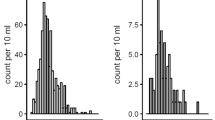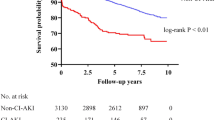Abstract
Purpose
Contrast-induced nephropathy is a common clinical concern in patients undergoing neuroendovascular procedures, especially in those with pre-existent kidney disease. We aimed to define the incidence of contrast-induced nephropathy in these high-risk patients in our practice.
Methods
We analyzed data retrospectively from patients undergoing neuroendovascular procedures at two academic medical centers over a 4-year period. Contrast-induced nephropathy was determined by an absolute increase in serum creatinine of 0.5 mg/dL or a rise from its baseline value by ≥ 25%, at 48–72 h after exposure to contrast agent after excluding other causes of renal impairment. High-risk patients were identified as those with pre-procedural estimated glomerular filtration rate < 60 mL/min irrespective of creatinine level, corresponding to stages 3–5 of chronic kidney disease.
Results
One hundred eighty-five high-risk patients undergoing conventional cerebral angiography and neuroendovascular interventions were identified. Only 1 out of 184 (0.54%) high-risk patients developed contrast-induced nephropathy. That one patient had stage 5 chronic kidney disease and multiple other risk factors.
Conclusion
We have observed a very low rate of renal injury in patients with chronic kidney disease, traditionally considered high risk for neuroendovascular procedures. Multiple factors may be responsible in the risk reduction of contrast-induced nephropathy in this patient population.


Similar content being viewed by others
Abbreviations
- CIN:
-
Contrast-induced nephropathy
- CCA:
-
Conventional cerebral angiography
- DM:
-
Diabetes mellitus
- CKD:
-
Chronic kidney disease
- CHF:
-
Congestive heart failure
- eGFR:
-
Estimated glomerular filtration rate
- NAC:
-
N acetyl cysteine
References
Mehran R, Nikolsky E (2006) Contrast-induced nephropathy: definition, epidemiology, and patients at risk. Kidney Int Suppl 100:S11–S15
ACR Manual on Contrast Media (2016) American College of Radiology. ACR Committee on Drugs and Contrast Media V 10(2):33–44
Nikolsky E, Aymong ED, Dangas G, Mehran R (2003) Radiocontrast nephropathy: identifying the high-risk patient and the implications of exacerbating renal function. Rev Cardiovasc Med 4(Suppl 1):S7–S14
Tepel M, Aspelin P, Lameire N (2006) Contrast-induced nephropathy: a clinical and evidence-based approach. Circulation 113(14):1799–1806
K/DOQI clinical practice guidelines for chronic kidney disease: Evaluation, classification, and stratification (2002). Am J Kidney Dis 39 (2 Suppl 1):S1–266
Coresh J, Astor BC, Greene T, Eknoyan G, Levey AS (2003) Prevalence of chronic kidney disease and decreased kidney function in the adult US population: Third National Health and Nutrition Examination Survey. Am J Kidney Dis 41(1):1–12
Katzberg RW, Newhouse JH (2010) Intravenous contrast medium-induced nephrotoxicity: is the medical risk really as great as we have come to believe? Radiology 256(1):21–28
McDonald JS, McDonald RJ, Comin J, Williamson EE, Katzberg RW, Murad MH, Kallmes DF (2013) Frequency of acute kidney injury following intravenous contrast medium administration: a systematic review and meta-analysis. Radiology 267(1):119–128
Tong GE, Kumar S, Chong KC, Shah N, Wong MJ, Zimmet JM, Wang ZJ, Yee J, Fu Y, Yeh BM (2016) Risk of contrast-induced nephropathy for patients receiving intravenous vs. intra-arterial iodixanol administration. Abdom Radiol (NY) 41(1):91–99
Prasad V, Gandhi D, Stokum C, Miller T, Jindal G (2014) Incidence of contrast material-induced nephropathy after neuroendovascular procedures. Radiology 273(3):853–858
Sharma J, Nanda A, Jung RS, Mehta S, Pooria J, Hsu DP (2013) Risk of contrast-induced nephropathy in patients undergoing endovascular treatment of acute ischemic stroke. J Neurointerv Surg 5(6):543–545
Lameire N, Adam A, Becker CR, Davidson C, McCullough PA, Stacul F, Tumlin J, Panel CINCW (2006) Baseline renal function screening. Am J Cardiol 98(6A):21K–26K
Aspelin P, Aubry P, Fransson SG, Strasser R, Willenbrock R, Berg KJ (2003) Nephrotoxic effects in high-risk patients undergoing angiography. N Engl J Med 348(6):491–499
McCullough PA, Wolyn R, Rocher LL, Levin RN, O’Neill WW (1997) Acute renal failure after coronary intervention: incidence, risk factors, and relationship to mortality. Am J Med 103(5):368–375
Brinjikji W, Demchuk AM, Murad MH, Rabinstein AA, McDonald RJ, McDonald JS, Kallmes DF (2017) Neurons over nephrons: systematic review and meta-analysis of contrast-induced nephropathy in patients with acute stroke. Stroke 48 (7):1862–1868
Tao Y, Dong W, Li Z, Chen Y, Liang H, Li R, Mo L, Xu L, Liu S, Shi W, Zhang L, Liang X (2017) Proteinuria as an independent risk factor for contrast-induced acute kidney injury and mortality in patients with stroke undergoing cerebral angiography. J Neurointerv Surg 9(5):445–448
Fishbane S (2008) N-acetylcysteine in the prevention of contrast-induced nephropathy. Clin J Am Soc Nephrol: CJASN 3(1):281–287
Jo SH, Youn TJ, Koo BK, Park JS, Kang HJ, Cho YS, Chung WY, Joo GW, Chae IH, Choi DJ, Oh BH, Lee MM, Park YB, Kim HS (2006) Renal toxicity evaluation and comparison between visipaque (iodixanol) and hexabrix (ioxaglate) in patients with renal insufficiency undergoing coronary angiography: the RECOVER study: a randomized controlled trial. J Am Coll Cardiol 48(5):924–930
Barrett BJ, Katzberg RW, Thomsen HS, Chen N, Sahani D, Soulez G, Heiken JP, Lepanto L, Ni ZH, Ni ZH, Nelson R (2006) Contrast-induced nephropathy in patients with chronic kidney disease undergoing computed tomography: a double-blind comparison of iodixanol and iopamidol. Investig Radiol 41(11):815–821
Solomon RJ, Natarajan MK, Doucet S, Sharma SK, Staniloae CS, Katholi RE, Gelormini JL, Labinaz M, Moreyra AE, Investigators of the CS (2007) Cardiac Angiography in Renally Impaired atients (CARE) study: a randomized double-blind trial of contrast-induced nephropathy in patients with chronic kidney disease. Circulation 115(25):3189–3196
Liss P, Persson PB, Hansell P, Lagerqvist B (2006) Renal failure in 57 925 patients undergoing coronary procedures using iso-osmolar or low-osmolar contrast media. Kidney Int 70(10):1811–1817
Heinrich MC, Haberle L, Muller V, Bautz W, Uder M (2009) Nephrotoxicity of iso-osmolar iodixanol compared with nonionic low-osmolar contrast media: meta-analysis of randomized controlled trials. Radiology 250(1):68–86
Pandya B, Chaloub J, Parikh V, Gaddam S, Spagnola J, El-Sayegh S, Bogin M, Kandov R, Lafferty J, Bangalore S (2017) Contrast media use in patients with chronic kidney disease undergoing coronary angiography: a systematic review and meta-analysis of randomized trials. Int J Cardiol 228:137–144
Rudnick MR, Davidson C, Laskey W, Stafford JL, Sherwin PF, Investigators VT (2008) Nephrotoxicity of iodixanol versus ioversol in patients with chronic kidney disease: the Visipaque Angiography/Interventions with Laboratory Outcomes in Renal Insufficiency (VALOR) Trial. Am Heart J 156(4):776–782
Author information
Authors and Affiliations
Corresponding author
Ethics declarations
Funding
No funding was received for this study.
Conflict of interest
The authors declare that they have no conflict of interest.
Ethical approval
All procedures performed in the studies involving human participants were in accordance with the ethical standards of the institutional and/or national research committee and with the 1964 Helsinki Declaration and its later amendments or comparable ethical standards. For this type of study formal consent is not required.
Informed consent
For this type of retrospective study formal consent is not required.
Rights and permissions
About this article
Cite this article
Kim, J., Male, S., Jagadeesan, B.D. et al. Safety of cerebral angiography and neuroendovascular therapy in patients with chronic kidney disease. Neuroradiology 60, 529–533 (2018). https://doi.org/10.1007/s00234-018-1996-2
Received:
Accepted:
Published:
Issue Date:
DOI: https://doi.org/10.1007/s00234-018-1996-2




